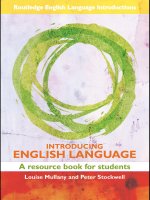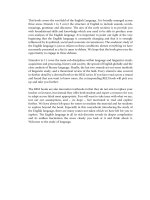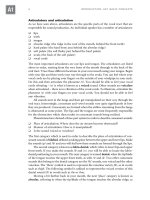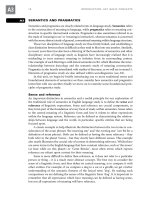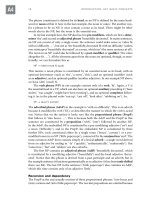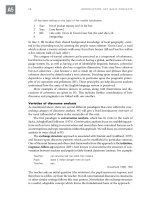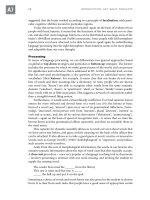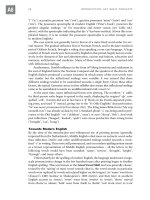Introdungcing English language part 2 pot
Bạn đang xem bản rút gọn của tài liệu. Xem và tải ngay bản đầy đủ của tài liệu tại đây (145.91 KB, 6 trang )
This book covers the vast field of the English Language. It is broadly arranged across
three areas. Strands 1 to 5 cover the structure of English to include sounds, words,
meanings, grammar and discourse. The aim of the early sections is to provide you
with foundational skills and knowledge which you need to be able to produce your
own analyses of the English language. It is important to point out right at the very
beginning that the English language is constantly changing and that it is strongly
influenced by its political, social and economic circumstances. The academic study of
the English language is just as reliant on these conditions: almost everything we have
necessarily presented as a fact is open to debate. We hope that the book gives you the
opportunity to engage in these debates.
Strands 6 to 11 cover the main sub-disciplines within language and linguistics study:
acquisition and processing, history and society, the spread of English globally and the
close analysis of literary language. Finally, the last two strands set out some methods
of linguistic study, and a theoretical review of the field. Every strand is also covered
in further detail by a devoted book in the RELI series. If you have read across a strand
and found that you want to know more, the corresponding RELI book will pick you
up and take you further.
The RELI books are also innovative textbooks in that they do not aim to replace your
teacher or lecturer, but instead they offer both student and expert a resource for you
to adapt as you think most appropriate. You will want to take issue with what we say,
test out our assumptions, and – we hope – feel motivated to read and explore
further. We have always left space for tutors to mediate the material and for students
to explore beyond the book. Especially in this coursebook introducing the study of
the English language, there are many routes not taken which we have left for you to
explore. The English language in all its rich diversity reveals its deeper complexities
and its endless fascination the more closely you look at it and think about it.
Welcome to the study of language.
CONTENTS
Contents cross-referenced x
Acknowledgements xii
A Introduction: key basic concepts 1
1 Phonetics and phonology 2
2 Morphology and lexicology 6
3 Semantics and pragmatics 10
4 Grammatical parts 14
5 Text and discourse 19
6 Early language acquisition 23
7 Psycholinguistics 27
8 History of English 30
9 Sociolinguistics 35
10 World Englishes 39
11 Stylistics 43
12 Methodological paradigms 48
13 Language theories 52
B Development: aspects of English 57
1 Consonants and vowels 58
2 Lexical semantics 64
3 Pragmatic principles 67
4 Syntax 73
5 Conversation 79
6 Literacy 84
7 Schemas 88
8 Standardisation 91
9 Language attitudes 95
10 Codification 99
11 Stylistic analysis 103
12 Techniques and ethics 107
13 Language and thought 111
C Exploration: investigating English language 117
1 Performing accents 118
2 Word plays 125
3 Doing politeness 129
4 Syntactic effects 135
viii CONTENTS
5 Texts in action 139
6 Learning to read 144
7 Exploring the mind 150
8 Corrections 155
9 Identify yourself 161
10 Influencing language 165
11 Exploring literature 171
12 Collecting data 178
13 Theory into practice 186
D Extension: linguistic readings 191
1 Glottalisation in Cardiff (Collins and Mees) 192
2 The search for units of meaning (Sinclair) 200
3 The speech acts of the in-group (Cutting) 206
4 Prefabricated expressions in spoken language (Cheshire) 214
5 Advertising discourse (Cook) 220
6 Socialisation and grammatical development (Ochs and Schieffelin) 226
7 Promoting perception (Field) 232
8 Lexical change (Smith) 239
9 Social relationships and social practices (Milroy and Gordon) 245
10 The development of World Englishes (Kirkpatrick) 251
11 Transitivity as point of view (Simpson) 257
12 Qualitative, quantitative, and mixed methods research (Dörnyei) 265
13 Researching ‘real’ language (Carter and Sealey) 271
Further reading 278
References 282
Glossarial index 297
CONTENTS CROSS-REFERENCED
INTRODUCTION DEVELOPMENT
1 Sounds
2 Words
3 Meanings
4 Grammar
5 Discourse
6 Acquisition
7 Processing
8 History
9 Society
References
Further
reading
Glossarial
Index
Phonetics and phonology
2
Consonants and vowels
58
Morphology and lexicology
6
Lexical semantics
64
Semantics and pragmatics
10
Pragmatic principles
67
Grammatical parts
14
Syntax
73
Text and discourse
19
Conversation
79
Early language acquisition
23
Psycholinguistics
27
Literacy
84
Schemas
88
History of English
30
Standardisation
91
Sociolinguistics
35
Language attitudes
95
Topic
10 Globalisation
World Englishes
39
Codification
99
11 Stylistics
Stylistics
43
Stylistic analysis
103
12 Methods
Methodological paradigms
48
Techniques and ethics
107
13 Theory
Language theories
52
Language and thought
111
Performing accents
118
Glottalisation in Cardiff
(Collins/Mees)
192
CONTENTS CROSS-REFERENCED
EXPLORATION EXTENSION
Word plays
125
The search for units of meaning
(Sinclair)
200
Doing politeness
129
The speech acts of the in-group
(Cutting)
206
Syntactic effects
135
Prefabricated expressions in spoken
language (Cheshire)
214
Texts in action
139
Advertising discourse
(Cook)
220
Learning to read
144
Socialisation and grammatical
development (Ochs/Schieffelin)
226
Exploring the mind
150
Corrections
155
Identify yourself
161
Promoting perception
(Field)
232
Lexical change
(Smith)
239
Social relationships and social practices
(Milroy/Gordon)
245
Influencing language
165
The development of World Englishes
(Kirkpatrick)
251
Exploring literature
171
Transitivity as point of view
(Simpson)
257
Collecting data
178
Qualitative, quantitative, and mixed
methods research (Dörnyei)
265
1 Sounds
2 Words
3 Meanings
4 Grammar
5 Discourse
6 Acquisition
7 Processing
8 History
9 Society
References
Further
reading
Glossarial
Index
10 Globalisation
11 Stylistics
12 Methods
13 Theory
Theory into practice
186
Researching ‘real’ language
(Carter/Sealey)
271
Topic

